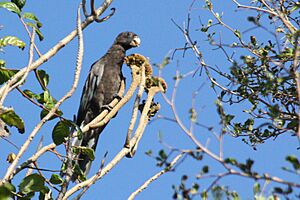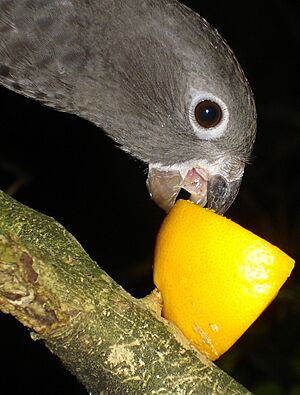Lesser vasa parrot facts for kids
Quick facts for kids Lesser vasa parrot |
|
|---|---|
 |
|
| Coracopsis nigra in Anjajavy Forest, Madagascar | |
| Conservation status | |
| Scientific classification | |
| Genus: |
Coracopsis
|
| Species: |
nigra
|
| Synonyms | |
|
|
The lesser vasa parrot or black parrot (Coracopsis nigra) is a cool black parrot that is only found in Madagascar. It's one of four types of vasa parrots. The others are the greater vasa parrot (C. vasa), the Seychelles black parrot (C. barklyi), and the Comoros black parrot (C. sibilans). The Seychelles and Comoros black parrots used to be thought of as the same species as the lesser vasa parrot.
Lesser vasa parrots live in the mangrove swamps and green evergreen forests of Madagascar. They enjoy eating seeds, flowers, and fruit. Their favorite foods include berries and mangos.
These parrots build their nests inside hollow trees. They start their courtship (when they look for a mate) in February. During this time, the female parrot might lose the feathers on her head, making it look yellowish. The male's beak might also turn white.

Contents
About the Lesser Vasa Parrot
The lesser vasa parrot is a unique bird found only on the island of Madagascar. It's known for its dark feathers and interesting habits. These parrots are quite active and can often be seen flying through the trees or looking for food.
What They Look Like
The lesser vasa parrot is mostly black, which is why it's also called the black parrot. During mating season, some cool changes happen! Female parrots might lose the feathers on their heads, making their skin look yellowish. Male parrots can also have their beaks turn white during this special time.
Where They Live and What They Eat
These parrots love to live in two main types of places in Madagascar:
- Mangrove swamps, which are coastal areas with special trees that grow in salty water.
- Evergreen forests, where trees stay green all year round.
Their diet is mostly plant-based. They enjoy a variety of foods found in their habitat, including:
- Seeds
- Blossoms (flowers)
- Different kinds of fruit, especially berries and juicy mangos.
Nesting and Family Life
When it's time to have babies, lesser vasa parrots choose safe spots. They build their nests inside holes in trees. This keeps their eggs and young chicks safe from predators.
Their breeding season starts around February. This is when they begin their courtship rituals. These rituals are how male and female parrots find a mate and prepare to raise a family together.
History and Naming
The lesser vasa parrot has been known to scientists for a long time. In 1743, a British naturalist named George Edwards drew and described this parrot. He called it the "Black Parrot from Madagascar." His drawing was made from a live bird that belonged to a duke!
Later, in 1758, the famous Swedish scientist Carl Linnaeus gave the parrot its scientific name, Psittacus niger. The word niger is Latin for "black," which makes sense for this parrot! Today, the lesser vasa parrot is placed in a different group, or genus, called Coracopsis.
There are two main types, or subspecies, of the lesser vasa parrot:
- Coracopsis nigra libs: Found in western and southern Madagascar.
- Coracopsis nigra nigra: Found in eastern Madagascar.



